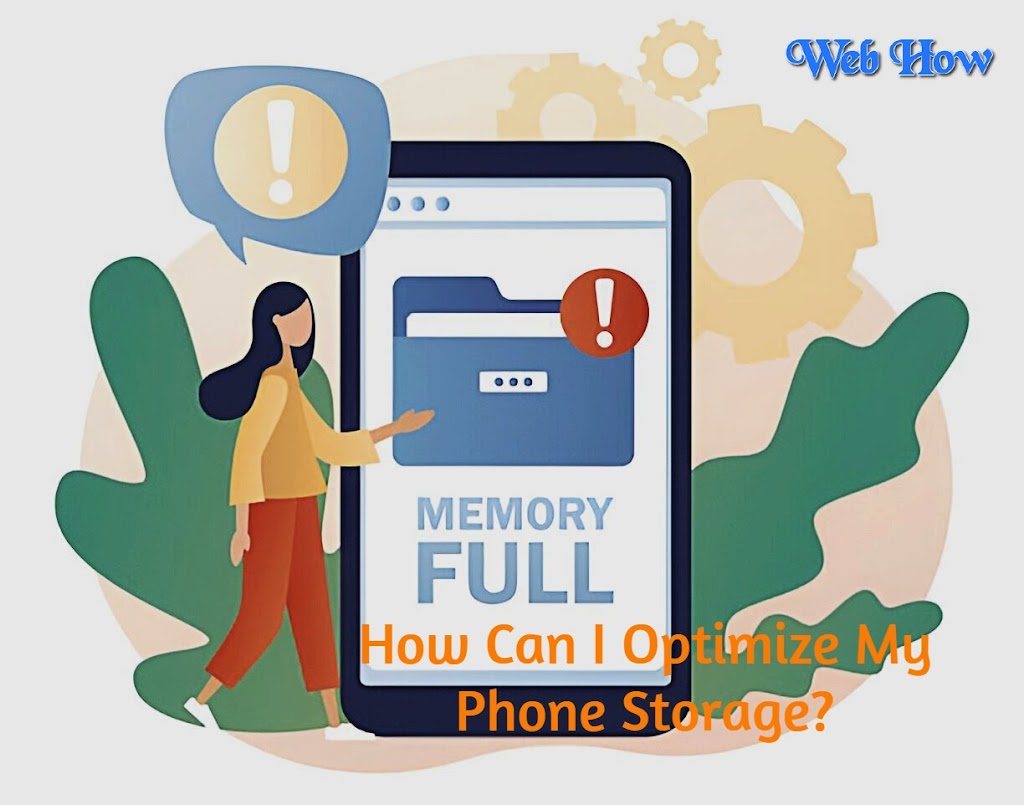How Can I Optimize My Phone Storage?
1. Assess Your Storage Usage
Before you start cleaning up your smartphone, it’s important to understand how your storage is being used. Both Android and iOS devices provide built-in tools to help you analyze your storage usage.
For Android:
-
Open Settings: Go to the “Settings” app on your device.
-
Storage: Tap on “Storage” or “Storage & USB” to view a breakdown of how much space is being used by different categories such as apps, photos, videos, and more.
-
Review: Review the usage to identify which categories are consuming the most space.
 |
| How To |
For iOS:
-
Open Settings: Navigate to the “Settings” app.
-
General: Tap on “General” and then “iPhone Storage” or “iPad Storage.”
-
Review: iOS will provide a detailed breakdown of your storage usage and recommendations for optimizing your storage.
2. Uninstall Unnecessary Apps
Apps are often the biggest culprits when it comes to consuming smartphone storage.We frequently amass apps over time that we seldom ever use. It’s time to declutter.
How to Uninstall Apps on Android:
-
Open Settings: Go to “Settings” and select “Apps” or “Applications.”
-
Select App: Tap on the app you want to uninstall.
-
Uninstall: To get rid of the app from your smartphone, tap “Uninstall”.
How to Uninstall Apps on iOS:
-
Long Press: Press and hold the app icon on your home screen until it starts to jiggle.
-
Delete App: Tap the “X” icon on the app you want to remove and confirm the deletion.
Regularly review your apps and remove those you no longer need to free up significant storage space.
3. Clear App Cache and Data
Apps store temporary files and data, known as cache, which can accumulate over time and take up a lot of space. Clearing the cache can help free up storage without affecting your app’s performance.
Clearing Cache on Android:
-
Open Settings: Go to “Settings” and select “Storage.”
-
Cached Data: Tap on “Cached data” and confirm to clear the cache for all apps.
Clearing Cache on iOS:
iOS does not provide a direct way to clear app caches. However, you can delete and reinstall apps to achieve a similar result.
4. Manage Photos and Videos
Photos and videos are often the largest files on our smartphones. Managing these files efficiently can free up a significant amount of space.
Backup and Delete:
-
Cloud Storage: Use cloud storage services like Google Photos, iCloud, or Dropbox to back up your photos and videos. Once backed up, you can delete them from your device to save space.
-
External Storage: Transfer photos and videos to an external hard drive or a computer.
Compress and Optimize:
-
Compression Apps: Use apps like Google Photos on Android or iOS’s built-in optimization feature to compress photos and videos without significantly reducing quality.
-
Delete Duplicates: Use apps like Duplicate Photos Fixer to find and delete duplicate photos.
5. Manage Downloads and Files
Downloads, documents, and other files can quickly pile up and take up valuable storage space. Regularly review and manage these files.
For Android:
-
File Manager: Use the built-in file manager or third-party apps like Files by Google to review and delete unnecessary files.
-
Downloads Folder: Check the “Downloads” folder and delete files you no longer need.
For iOS:
-
Files App: Use the Files app to access and manage your files.
-
Review Downloads: Regularly review and delete files in the “Downloads” section.
6. Use Storage Optimization Tools
Both Android and iOS offer storage optimization tools to help you manage and free up space.
For Android:
-
Files by Google: This app helps you manage files, clean up junk, and optimize storage.
-
Device Maintenance: Many Android devices have a built-in “Device Maintenance” or “Device Care” feature that provides recommendations for optimizing storage.
For iOS:
-
Offload Unused Apps: In the “iPhone Storage” section of Settings, you can enable “Offload Unused Apps,” which automatically removes unused apps but keeps their data.
-
Review Large Attachments: iOS also provides recommendations to review large attachments and files.
7. Clear Browser Cache and Data
Browsers store cache and data that can accumulate over time. Clearing this data can free up storage and improve browser performance.
Clearing Cache on Android:
-
Browser Settings: Open your browser and go to its settings.
-
Privacy: Look for the “Privacy” or “Data” section.
-
Clear Browsing Data: Select “Clear browsing data” and choose what you want to clear (cache, cookies, etc.).
Clearing Cache on iOS:
-
Safari: Go to “Settings” > “Safari” > “Clear History and Website Data.”
-
Other Browsers: For other browsers like Chrome, open the app, go to settings, and clear browsing data.
8. Manage Music and Podcasts
Music and podcast files can also take up a lot of space. Managing these files effectively can help free up storage.
For Android and iOS:
-
Streaming Services: Use streaming services like Spotify, Apple Music, or YouTube Music to avoid storing large music files on your device.
-
Download Management: Regularly review and delete downloaded music and podcasts you no longer listen to.
9. Disable or Limit Automatic Downloads
Automatic downloads can quickly fill up your storage with files you may not need. Limiting or disabling these settings can help control storage usage.
For Android:
-
Play Store: Open the Google Play Store, go to settings, and disable “Auto-update apps” or set it to “Over Wi-Fi only.”
-
Messaging Apps: In messaging apps like WhatsApp, go to settings and disable automatic media downloads.
For iOS:
-
App Store: Go to “Settings” > “App Store” and disable “App Updates” and “Automatic Downloads.”
-
Messaging Apps: In apps like WhatsApp, go to settings and manage automatic media downloads.
10. Regular Maintenance
Regular maintenance is key to keeping your smartphone storage optimized. Set a reminder to perform regular clean-ups and storage management.
Weekly or Monthly Tasks:
-
Review Apps: Check for and uninstall unused apps.
-
Clear Cache: Clear app and browser cache.
-
Manage Media: Review and delete unnecessary photos, videos, music, and files.
-
Backup: Regularly back up important data to cloud storage or external devices.
FAQs on “How Can I Optimize My Phone Storage?: Tech Tips for Optimal Performance”
1. Why is my smartphone storage filling up so quickly?
Smartphone storage can fill up quickly due to the accumulation of apps, photos, videos, documents, cached data, and automatic downloads. Regularly managing these files is essential to prevent storage from becoming full.
2. How can I check what is using up my storage space?
For Android:
-
Open Settings: Go to “Settings” and select “Storage” or “Storage & USB.”
-
View Breakdown: You will see a detailed breakdown of how much space is used by different categories like apps, photos, and videos.
For iOS:
-
Open Settings: Navigate to “Settings,” then “General,” and select “iPhone Storage” or “iPad Storage.”
-
View Breakdown: iOS provides a detailed overview of your storage usage, including recommendations for optimization.
3. What are the best ways to free up space on my smartphone?
-
Uninstall unnecessary apps.
-
Clear app cache and data.
-
Backup and delete photos and videos.
-
Manage and delete downloaded files.
-
Use storage optimization tools.
-
Clear browser cache and data.
-
Manage and delete music and podcasts.
-
Disable or limit automatic downloads.
4. How can I clear app cache on my smartphone?
For Android:
-
Open Settings: Go to “Settings” and select “Storage.”
-
Cached Data: Tap on “Cached data” and confirm to clear the cache for all apps.
For iOS:
iOS does not provide a direct method to clear app caches. To clear cache, you can delete and reinstall apps.
5. What should I do with my photos and videos to save storage?
-
Backup: Use cloud storage services like Google Photos, iCloud, or Dropbox to back up your photos and videos.
-
External Storage: Transfer photos and videos to an external hard drive or computer.
-
Optimize: Use apps or built-in features to compress photos and videos.
-
Delete Duplicates: Remove duplicate photos using apps like Duplicate Photos Fixer.
6. How can I manage my downloads and files effectively?
For Android:
-
File Manager: Use the built-in file manager or third-party apps like Files by Google to review and delete unnecessary files.
-
Downloads Folder: Regularly check and clean out the “Downloads” folder.
For iOS:
-
Files App: Use the Files app to access and manage your files.
-
Review Downloads: Regularly review and delete files in the “Downloads” section.
7. Are there any tools to help optimize my smartphone storage?
For Android:
-
Files by Google: Helps manage files, clean up junk, and optimize storage.
-
Device Maintenance: Built-in feature on many Android devices offering storage optimization recommendations.
For iOS:
-
Offload Unused Apps: Automatically removes unused apps while keeping their data.
-
Review Large Attachments: Provides recommendations to review and delete large attachments and files.
8. How can I clear browser cache and data on my smartphone?
For Android:
-
Browser Settings: Open your browser and navigate to its settings.
-
Privacy/Data: Look for the “Privacy” or “Data” section and select “Clear browsing data.”
For iOS:
-
Safari: Go to “Settings” > “Safari” > “Clear History and Website Data.”
-
Other Browsers: Open the browser app, go to settings, and clear browsing data.
9. How can I manage music and podcasts to save space?
-
Use streaming services like Spotify, Apple Music, or YouTube Music to avoid storing large files on your device.
-
Regularly review and delete downloaded music and podcasts you no longer listen to.
10. How can I limit automatic downloads to save storage space?
For Android:
-
Play Store: Open Google Play Store, go to settings, and disable “Auto-update apps” or set it to “Over Wi-Fi only.”
-
Messaging Apps: Disable automatic media downloads in the settings of messaging apps like WhatsApp.
For iOS:
-
App Store: Go to “Settings” > “App Store” and disable “App Updates” and “Automatic Downloads.”
-
Messaging Apps: Manage automatic media downloads in the settings of apps like WhatsApp.
11. How often should I perform maintenance on my smartphone storage?
Regular maintenance is key to keeping your smartphone storage optimized. Aim to perform the following tasks weekly or monthly:
-
Review and uninstall unused apps.
-
Clear app and browser cache.
-
Manage and delete unnecessary photos, videos, music, and files.
-
Backup important data to cloud storage or external devices.
By regularly maintaining your smartphone storage, you can ensure optimal performance and a seamless user experience.
Conclusion:
By following these tips and strategies, you can effectively clean up your smartphone storage and ensure optimal performance. A well-maintained smartphone not only performs better but also provides a smoother and more enjoyable user experience. Happy cleaning!


